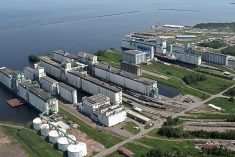Major miner BHP’s potash mine-in-progress in Saskatchewan has picked up $100 million in federal funding to go toward investments in low-emissions equipment.
Federal Industry Minister Francois-Philippe Champagne on Monday announced BHP’s Saskatoon-based Canadian arm will get backing from Innovation, Science and Economic Development Canada’s Strategic Innovation Fund (SIF) for the mine at Jansen, Sask., about 60 km southeast of Humboldt.
The Australian company’s $7.5 billion Jansen mine project is “expected to generate the lowest direct emissions of any potash mine in the world,” the department said in a release.
Read Also

More Canadian companies at Agritechnica 2025
A record number of Canadian agriculture machinery and tech companies are at Agritechnica 2025, with exporters being more aggresive looking for new markets.
The funding will go to “significantly minimize the carbon footprint of the mine, improve worker safety and implement technology to further reduce emissions from mine operations.”
A department representative said via email, the funding will go to “maximizing production efficiencies” of a full-face borer machine and extendable belt system at the mine.
It will also go toward “electrifying mining operations through deployment of battery electric vehicles and charging stations.”
“We know that being successful is not just about what you mine but also about how you mine, and we take this responsibility seriously,” Ragnar Udd, BHP’s president for minerals in the Americas, said in the government’s release.
The Jansen mine’s first stage, he said, “is setting a new standard for potash” which “will use the latest technology to deliver a productive, efficient and sustainable operation that will bring widespread benefits to the region, the people of Saskatchewan and BHP shareholders for decades to come.”
“Countries around the world look to Canada as a trusted partner for fertilizer,” federal Agriculture Minister Marie-Claude Bibeau said in the same release. “By investing in this low-emissions potash mine, Canada is improving the availability of this essential input to agricultural production that contributes to global food security, and it is doing so in a sustainable manner.”
First set out in the 2017 federal budget, the SIF goes to support “large-scale, transformative and collaborative projects that help position Canada to prosper in the global knowledge-based economy.”
Other SIF-backed projects in the ag and agrifood sectors have included $28 million for Maple Leaf Foods’ new poultry packing plant at London, Ont.; $20 million for Natural Products Canada to develop products such as biopesticides and feed ingredients; and $49.5 million for the Canadian Agri-Food Automation and Intelligence Network for automation and digitization projects in the ag sector. — Glacier FarmMedia Network















